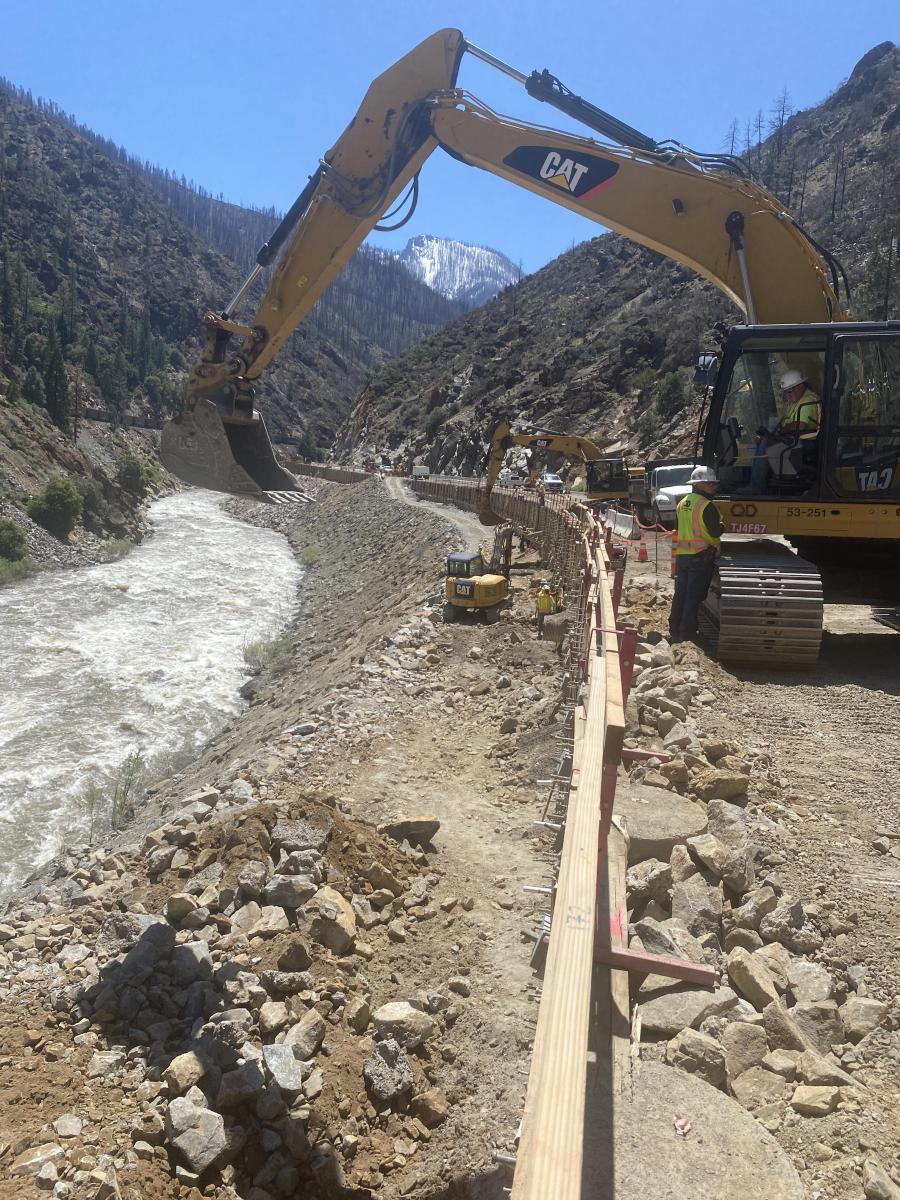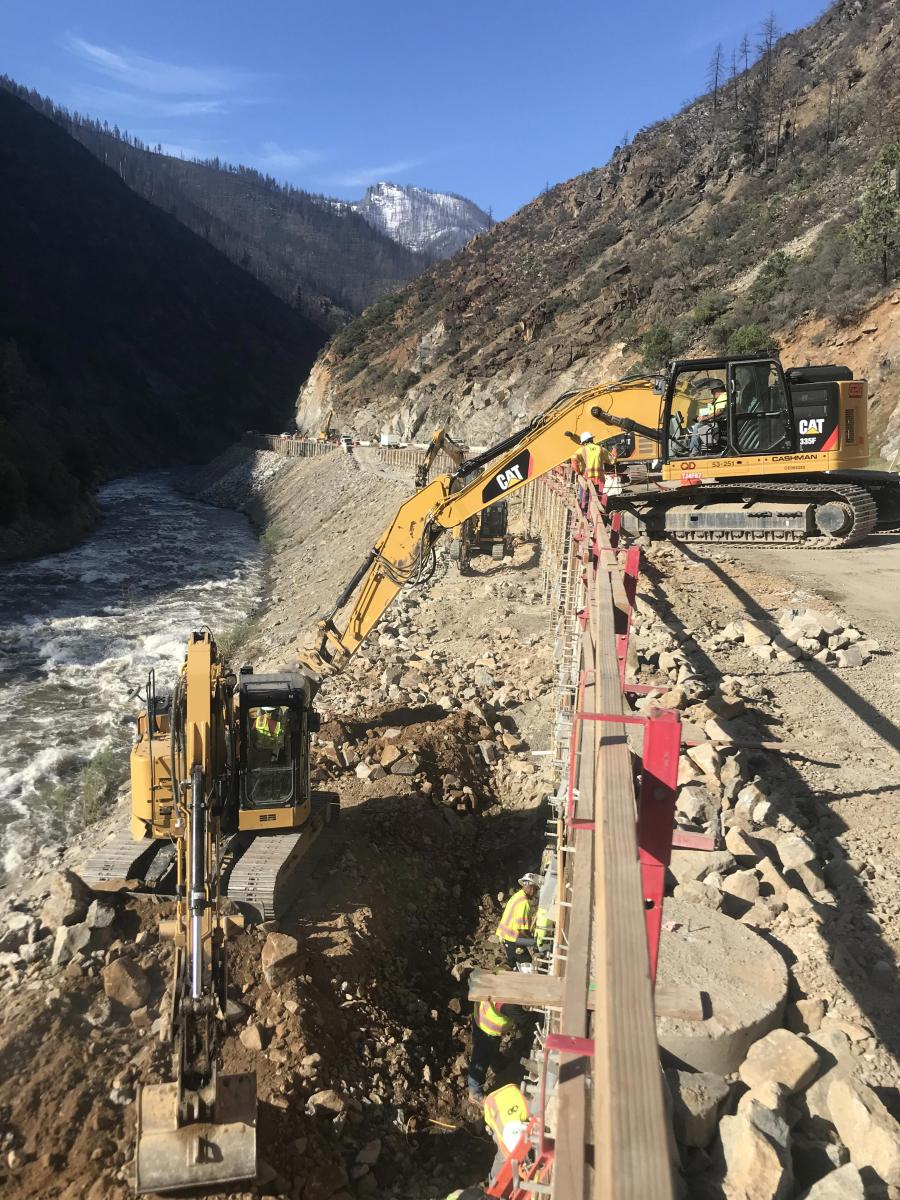Q&D Construction is performing extensive work on State Route 70 in Plumas County, Calif., to provide a permanent restoration for roadway slope scour in response to the 2017 storm event that resulted in damage along the Route 70 Feather River corridor.
(Q&D Construction photo)
Due to serious damage caused by storms, the California Department of Transportation (Caltrans) is working on a permanent restoration project along State Route 70 in Plumas County.
Q&D Construction LLC began work on July 11, 2022, and is expected to complete the project by 2024.
"This project will provide the ‘Permanent Restoration' for roadway slope scour in response to the 2017 qualifying storm event that resulted in storm damage along the Route 70 Feather River corridor," said Kurt Villavicencio, Caltrans Public information Officer, District 2. "It will stabilize and strengthen the roadway against future storm events and provide more effective drainage solutions."
Additional work is still required to create a more permanent solution after the roadway flooded in several locations six years ago, which caused extensive damage to the roadway and embankments. The Feather River is susceptible to high and frequent flood events due to the steep and narrow river canyon and frequency of "rain on snow" events. The existing highway embankments are exposed to high scour velocities and large boulder movements during peak river flow events.
The 30-mi. work zone in a mountain region of Plumas County is on State Route (SR) 70 at various locations, from the Butte County line to 3.1 mi. west of SR 89 junction. The hill on either side of the road is steep in certain portions, have a lot of exposed rock and few trees.
A combination of grouted Rock Slope Protection (RSP) clusters at seven locations and a soldier pile "tie-back retaining wall" at one location is being installed. In addition, eight culverts will be replaced along the route as the roadway embankment undergoes stabilization.
Caltrans designed the project for the two-lane SR 70, which has one shoulder lane.
The soldier pile wall location near Rich Bar will be reduced to one lane for a one half mile length with a temporary traffic signal.
Approximately 70 percent of the work has been completed.
Six of the eight locations have been finished, according to Jordan Ranson, Q&D's project engineer.
"Location 7 is where the wall is being built and we're roughly 60 percent complete there," he said.
This project is complex and subject to many challenges.
"One of the biggest is the location," said Ranson. "It's in a serpentine rock formation, which has 2,600 psi. They blasted out the side of the mountain where they cut the road. The bottom depth of the 40-foot holes that we're drilling is in blasted rock and about three feet in diameter on average. Drilling and excavating — that stuff is extremely difficult — it's a lot of wear and tear on our equipment. The construction of the retaining wall is difficult because it has to be constructed from the top down. We've had to innovate to come up with engineering solutions.
"The work is progressing and being built as designed," he added. "In the beginning, each scope was very slow and production had been rough, but we tended to meet production goals after the learning curve. We do have windows when we can't work in due to drainage and that was from November 15 to June 1 because of the run-off through the winter. We're in hard rock and hard pan conditions and there are a lot of voids in the ground where run-off and water will run through our project."
The areas adjacent to the work zones experienced three major landslides that completely covered the highway.
"There was one a mile away from our project that blocked us off," said Ranson. "We had some smaller ones in our work area. Working in a remote location has been difficult. It requires logistical strategies to bring in equipment and materials and things that we normally have easy access to."
A concrete batch plant was not needed as the site is 15 mi. from form concrete suppliers, but the landslides did require that three ready-mix producers be utilized due to blocked roads.
"The difficult nature of the project has brought about lot of change orders and a lot of problems," said Ranson. "There has been a lot of unforeseen difficulties and we've had to ask Caltrans for additional compensation.
"As far as the challenges of doing grouted rip-rap, we couldn't do it in the eight by eight feet clusters that they wanted us to do," said Ranson. "We changed the design a bit to be more practical, similar to strips. We had to modify the slump of our concrete and changed it to something like a shotcrete mix design that we put through a normal pump with a different style hose. That way we could prevent concrete from running of the rock down the really steep slopes."
No drilling was required for this element of the project, with each cluster taking between two to three days to complete.
"We were, on average, 25 to 30 feet above the river," said Ranson. "We sat the pump on the road and then our guys would climb down the slope and install the grout in between the rip-rap."
Efforts are continuing on the soldier pile "Tie-Back Retaining Wall, which is 2,250 feet long.
"Part of the wall pushed towards the river," said Ranson. "Because the overall project was re-aligning the highway and changing the curvature a little bit to create better sight lines, our plan of attack was to build that alignment section first. We had to dig a bench 15 feet down by the road so that our drill could reach down to where the piles needed to be drilled as the pushed out from the river so far. As they couldn't go down the slope, we created an access point. After we did this, we moved west."
There are 282 piles for the total length of the wall. Each shaft drilled was 30 in. in diameter.
The wall is being built from the top down, supported by a timber lagging system. Structural concrete is being poured to fill the piles and establish the wall, along with the pouring of slurry at the very top.
‘We can't access the bottom of the wall because it's essentially a cliff," said Ranson. "We excavated from the top down to where the horizontal ground access location is, a total of seven feet deep. They anchored the wall horizontally and then we installed the timber lagging that provided shoring capability. The ideal plan is to excavate and also install the timber lagging at the same time as they go down.
"This has been done before, but none at Caltrans and our organization built a wall this way," he added. "It was quite an obstacle to figure out how to do this. We innovated and found solutions. I tried to find another wall like it, but they were built from the ground upwards."
Work on the wall began on July 12 last year and will resume shortly.
Of the eight culverts, all have been completed for two lifts and culverts along the wall. They will be installed after the wall is finished.
‘The culverts cross the road, perpendicular to the wall and they daylight off of the front of the wall and run into the wilderness," said Ranson.
"It took us about two days per-crossing and it was like shooting through rocky conditions," said Ranson. "It was very different from culverts that would normally take us less than half-a-day."
Ranson is assisted by Project Manager Brett Amesbury.
"Our management style is very efficient," said Ranson. "I make sure the day-to-day stuff is handled and I am the strategic planner who works with the crews in the field. I have a good relationship with my foremen and field guys. We share information very well and summarize it, giving it to Brett. He helps make large strategic decisions and supports me in my efforts to secure extra work with Caltrans.
"This is some of the most dangerous work that we are conducting right now and the most technical work we are doing as a company," he added. "Our crews are working six days a week, putting in 12-hour days, keeping the project on schedule and finished on time."
Peak days have 25 to 30 Q&D and five to 10 subcontractor personnel on-site. The subcontractors include T&S DVBE Inc., M&S Environmental Landscapes Inc., F.D Thomas, Inc., KRC Safety Co. Inc., Apply-A-Line, LLC, Camblin Steel Services, Apex Fencing Co Inc., Jarrett Foundations Inc. and Neils Controlled Blasting.
Due to the remote work site, most Q&D employees are staying in personal camping trailers, with a few staying at local motels.
Excavation will generate 12,000 cu. yds. of rock and earth.
"Some of the rock is going to be re-purposed for rip-rap placement on the bench," said Ranson. "Serpentine rock is considered as potentially containing asbestos and nobody wants to use this rock. It's too much of a liability to be processed and repurposed. We're burying it and placing a 12-inch cap over it."
As for new materials, 1,500 cu. yds. of concrete will be poured and 124,000 lbs. of reinforcing of concrete, especially for the 2,250 linear ft. of wall.
As noted, equipment is essential to this project.
"We've seen the most severe damage on this project," said Ranson. "Anytime you are dealing with rocks, you get accelerated wear and tear on buckets, hydraulic components, and everything else. The drillers tore an entire Kelly Bar in half, They said they've never seen it happen before. We've had excavators completely destroy buckets that we had to replace."
This project is consistent with the Transportation Concept Report (TCR) for this route and "will reduce the risk of future closures on this east-west route for the movement of people and goods in Northern California," said Villavicencio. "SR 70 has the lowest elevation of any Trans-Sierra crossing, making it an important alternate highway freight corridor during snow conditions." CEG
Today's top stories























